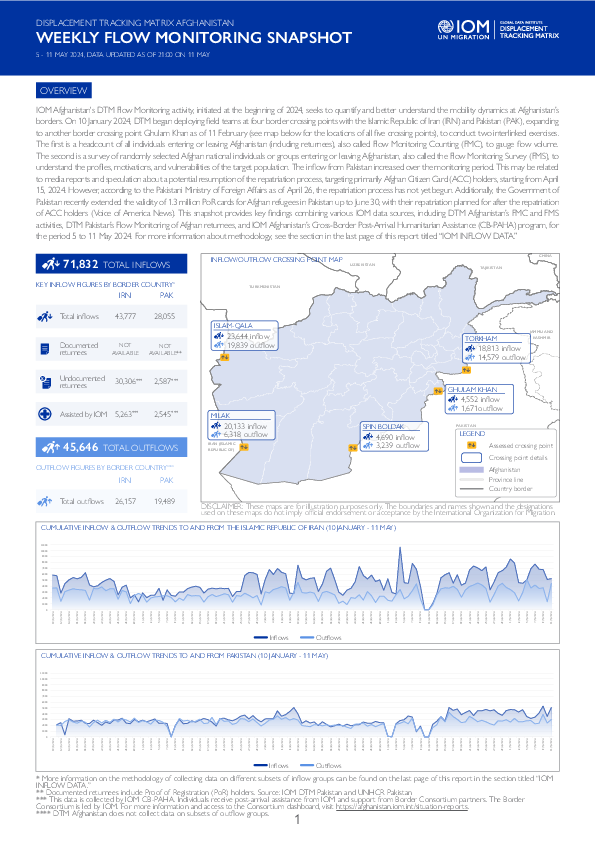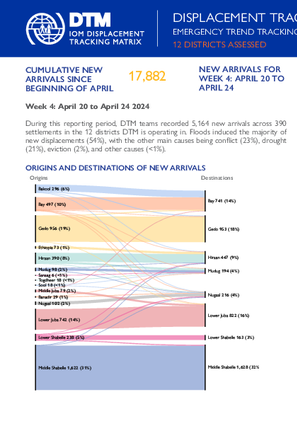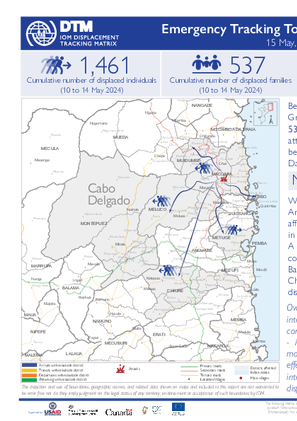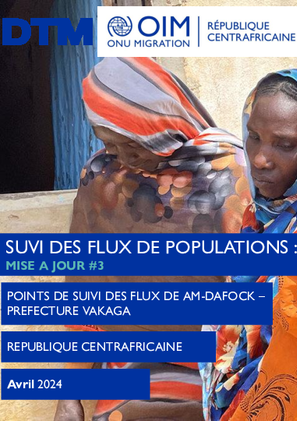-
Countries
-
Data and Analysis
-
Special Focus
-
Crisis Responses

Contact
DTMAfghanistan@iom.int
Language
English
Location
Afghanistan
Period Covered
May 05 2024
May 11 2024
Activity
- Survey
- Flow Monitoring Survey
- Flow Monitoring
IOM Afghanistan's DTM Flow Monitoring activity, initiated at the beginning of 2024, seeks to quantify and better understand the mobility dynamics at Afghanistan’s borders. On 10 January 2024, DTM began deploying field teams at four border crossing points with the Islamic Republic of Iran (IRN) and Pakistan (PAK), expanding to another border crossing point Ghulam Khan as of 11 February (see map below for the locations of all five crossing points), to conduct two interlinked exercises. The first is a headcount of all individuals entering or leaving Afghanistan (including returnees), also called Flow Monitoring Counting (FMC), to gauge flow volume. The second is a survey of randomly selected Afghan national individuals or groups entering or leaving Afghanistan, also called the Flow Monitoring Survey (FMS), to understand the profiles, motivations, and vulnerabilities of the target population. The inflow from Pakistan increased over the monitoring period. This may be related to media reports and speculation about a potential resumption of the repatriation process, targeting primarily Afghan Citizen Card (ACC) holders, starting from April 15, 2024. However, according to the Pakistani Ministry of Foreign Affairs as of April 26, the repatriation process has not yet begun. Additionally, the Government of Pakistan recently extended the validity of 1.3 million PoR cards for Afghan refugees in Pakistan up to June 30, with their repatriation planned for after the repatriation of ACC holders (Voice of America News). This snapshot provides key findings combining various IOM data sources, including DTM Afghanistan’s FMC and FMS activities, DTM Pakistan’s Flow Monitoring of Afghan returnees, and IOM Afghanistan’s Cross-Border Post-Arrival Humanitarian Assistance (CB-PAHA) program, for the period 5 to 11 May 2024. For more information about methodology, see the section in the last page of this report titled “IOM INFLOW DATA.”

Contact
DTM Somalia, IOMSomaliaDTM@iom.int
Language
English
Location
Somalia
Period Covered
Apr 20 2024
Apr 24 2024
Activity
- Mobility Tracking
- Baseline Assessment
This latest round of Emergency Trends Tracking was initiated in April 2024 to monitor displacements movements during the Gu rainy season. Districts covered in this round include Afgooye, Afmadow, Baardheere, Baidoa, Balcad, Belet Weyne, Gaalkacyo, Garoowe, Jamaame, Jowhar, Kismaayo, and Luuq.
ETT is a crisis-based tool that tracks sudden displacement triggered by specific events or emerging crises. The objective of ETT is to help prioritize humanitarian response and to enable partners to deliver rapid assistance. Based on previous shock induced displacement patterns, the humanitarian community expects that people will continue to move toward urban areas in search of humanitarian services. Consequently, the ETT coverage focuses on the main urban centers and surrounding villages for each assessed district. The data is collected through Key Informant Interviews (KIIs) at the location level, from Sunday to Wednesday every week. It includes information on new arrivals, numbers and demographic of IDPs, reasons for displacement, intentions, humanitarian assistance and priority needs among others.
This report presents the main findings from the Displacement Tracking Matrix (DTM) Flow Monitoring Surveys (FMS) deployed in Greece, Italy, and Spain in 2023. FMS provide a snapshot of the profiles, experiences, and needs of migrants. The survey asks questions on demographics, education and employment backgrounds, the circumstances of the migration journey and migration factors, as well as future intentions and vulnerabilities to abuse, exploitation and violence.
In 2023, a total of 4,020 surveys were collected in 130 entry and transit points for migrants arriving by land and by sea to Europe. The report explores similarities and differences among migrants travelling along the Eastern Mediterranean Route (EMR), the Central Mediterranean Route (CMR), the Western Mediterranean Route (WMR) and the Western African Atlantic Route (WAAR) (3,626 surveys). A separate section also looks at the evidence from migrants interviewed in the North of Italy, entering by land from Slovenia (394), connecting this with analyses carried out in the Western Balkan (WB) region. A final section addresses the conditions and needs of migrant children (14-17 years old) in the sample.

Contact
DTMMozambique@iom.int
Language
English
Location
Mozambique
Period Covered
May 10 2024
May 14 2024
Activity
- Mobility Tracking
- Event Tracking
Between 10 to 14 May 2024, attacks, and fear of attacks by Non-state Armed Groups in Macomia triggered the cumulative displacement of 1,461 individuals/ 537 families. The current Movement Alert #112 reports on most recent attacks in Northen Cabo Delgado. For more information on displacements between January and April, please see {Emergency Tracking Online Dashboard}.
Contact
DTM Somalia Location
Somalia
Activity
- Mobility Tracking
- Event Tracking
Period Covered
Mar 30 2024 -Apr 24 2024
This latest round of Emergency Trends Tracking was initiated in April 2024 to monitor displacements movements during the Gu rainy season. Districts covered in this round include Afgooye, Afmadow, Baardheere, Baidoa, Balcad, Belet Weyne, Gaalkacyo, Garoowe, Jamaame, Jowhar, Kismaayo, and Luuq.
ETT is a crisis-based tool that tracks sudden displacement triggered by specific events or emerging crises. The objective of ETT is to help prioritize humanitarian response and to enable partners to deliver rapid assistance. Based on previous shock induced displacement patterns, the humanitarian community expects that people will continue to move toward urban areas in search of humanitarian services. Consequently, the ETT coverage focuses on the main urban centers and surrounding villages for each assessed district. The data is collected through Key Informant Interviews (KIIs) at the location level, from Sunday to Wednesday every week. It includes information on new arrivals, numbers and demographic of IDPs, reasons for displacement, intentions, humanitarian assistance and priority needs among others.
The ETT tool also adapts to regional contexts: because of the very high number of IDP sites in Khada and Daynile districts in Banadir region and in Baidoa district in Bay region, a zonal approach has been adopted for these areas. Each week, KIIs are first conducted at the zone level to indicate to the field teams which locations have received the most new arrivals and which need to be assessed.
To facilitate the joint analysis of the CCCM (Camp Coordination and Camp Management) Cluster’s New Arrivals Tracker (NAT) and ETT data, the assistance and needs indicators are identical in both tools.
Population Groups
IDPs
Survey Methodology
Unit of Analysis Or Observation
Site or Location
Type of Survey or Assessment
Key Informant
Keywords
Geographical Scope Partial Coverage
Administrative boundaries with available data
The current dataset covers the following administrative boundaries
This snapshot on nationals from Pakistan in Europe is part of the outputs of IOM’s EU-funded Displacement Tracking Matrix - Regional Evidence for Migration Analysis and Policy (DTM REMAP) project. The snapshot is divided into three sections:
Firstly, it provides information on the number of Pakistani nationals who arrived by land and sea in Europe and those who transited through the Western Balkan and Eastern Europe region in 2023. The data on arrivals and transits is made available by national authorities and then gathered by the IOM DTM team in Europe.
Secondly, it delves into the demographic distribution of Pakistani nationals residing in Europe, categorized by gender and geographical regions within Europe, utilizing data reported by Eurostat and the UK Office of Statistics.
Lastly, the report encapsulates the insights gained from the Flow Monitoring Survey (FMS) conducted by the DTM Europe team, engaging with 373 Pakistani nationals across seven European countries throughout 2023.

Contact
DTM Sudan, SudanDTM@iom.int
Language
English
Location
Sudan
Period Covered
Apr 29 2024
May 07 2024
Activity
- Other
Following the increase in localized displacement due to fires, DTM Sudan released the following report summarizing DTM updates on displacement due to fire incidents across Sudan, from 29 April to 07 May 2024.
DTM field teams reported seven fire incidents across North Darfur (2), South Darfur (2), East Darfur (2), West Kordofan (1), and Gedaref state (1). Some fires were reportedly caused by increased temperatures and drier climate conditions, while others were due to household accidents.
Highlights
- Fires displaced an estimated 1,900 individuals (approximately 380 households) between 29 April and 07 May 2024.
- Over 355 houses were partially damaged or destroyed by the fires.
- The fires resulted in localized displacement: the majority of displaced households sought shelter with host communities within the same locations.

Contact
DTM Ukraine, dtmukraine@iom.int
Language
English
Location
Ukraine
Period Covered
Feb 12 2024
Mar 15 2024
Activity
- Other
The War in Ukraine has caused massive displacement, with about 3.7 million people forced to flee their homes, land, and families. Most of them want to go back to where they came from, underlining the pressing need for a recovery and transition strategy that links humanitarian and development efforts, addresses the immediate needs of the communities affected by displacement, and prepares them for their collective future. Aware of this necessity and in line with the global action on internal displacement, the Ukrainian government, the UN, and partners are implementing a comprehensive recovery and transition plan that prioritises data-based approaches and participation so that the displaced people and their host communities can shape and achieve lasting solutions to their displacement.
This research report examines the views of the displaced and their hosts to understand their experiences, hopes, and preferences for durable solutions. It provides useful insights to inform the creation of a 'Joint Analytical Framework' in Ukraine to track progress towards solutions pathways and guide future policies and programs.

Contact
DTM Europe, DTMMediterranean@iom.int
Language
English
Location
Italy
Period Covered
Aug 04 2023
Dec 27 2023
Activity
- Survey
- Flow Monitoring
This report presents the results of the Displacement Tracking Matrix (DTM) Flow Monitoring Surveys (FMS) deployed in Italy in 2023. The data were collected from 04 August to 27 December 2023 in three Italian regions (Calabria, Friuli Venezia Giulia, and Sicily).
IOM interviewed a total of 1,451 individual respondents. FMS provide a snapshot of the profiles, experiences, and needs of migrants. The survey asks questions on demographics, education and employment backgrounds, the circumstances of the migration journey and migration factors, as well as future intentions and vulnerabilities to abuse, exploitation and violence.

Contact
DTM Afghanistan, DTMKabul@iom.int
Language
French
Location
Central African Republic
Period Covered
Feb 09 2024
Apr 02 2024
Activity
- Survey
- Flow Monitoring Survey
Afin de mieux comprendre les mouvements et tendances migratoires dans un espace géographique donné, l’Organisation Internationale pour
les Migrations (OIM), à travers la Matrice de suivi des déplacements (Displacement Tracking Matrix (DTM), en anglais), met en oeuvre l’activité de suivi des flux de populations (Flow Monitoring (FM), en anglais). Le suivi des flux est composé de deux outils : l’inventaire des flux (Flow Monitoring Registry (FMR), en anglais) et les enquêtes individuelles (Flow Monitoring Survey (FMS), en anglais). Le suivi des flux a pour objectif de recueillir des données sur le nombre et les caractéristiques des personnes en déplacement dans des zones à forte mobilité, à travers des points (postes) de suivi (Flow Monitoring Points (FMP), en anglais) installés dans ces zones. Cette activité facilite la compréhension des mouvements migratoires et permet de préparer des stratégies et des réponses appropriées dans un contexte migratoire mixte motivé par des facteurs concomitants tels que les conflits et les raisons économiques. Le conflit armé sévissant au Soudan depuis mi-avril 2023, continue d’occasionner le déplacement de milliers de personnes en provenance du Soudan vers la République Centrafricaine (RCA), l’OIM en coordination avec la Commission Nationale pour les Refugies (CNR), poursuit depuis le 9 Février 2024 ses activités de Flow Monitoring Survey (FMS) et le Flow Monitoring Registry (FMR) au niveau du point d’entrée de Am-dafock, situé dans la préfecture de Vakaga à la frontière entre la RCA et le Soudan. Cette activité consiste à inventorier le nombre de personnes entrant de part et d'autre de la frontière, définir leurs profils, motivations, destinations et intentions futures. L’activité est conduite par des partenaires opérationnels de la DTM.
Ce tableau de bord présente des analyses basées sur les informations collectées entre le 09 février au 02 Avril 2024 sur un échantillon des
populations migrantes ayant franchi le point d’entrée d’Am-dafock lors cette période.

